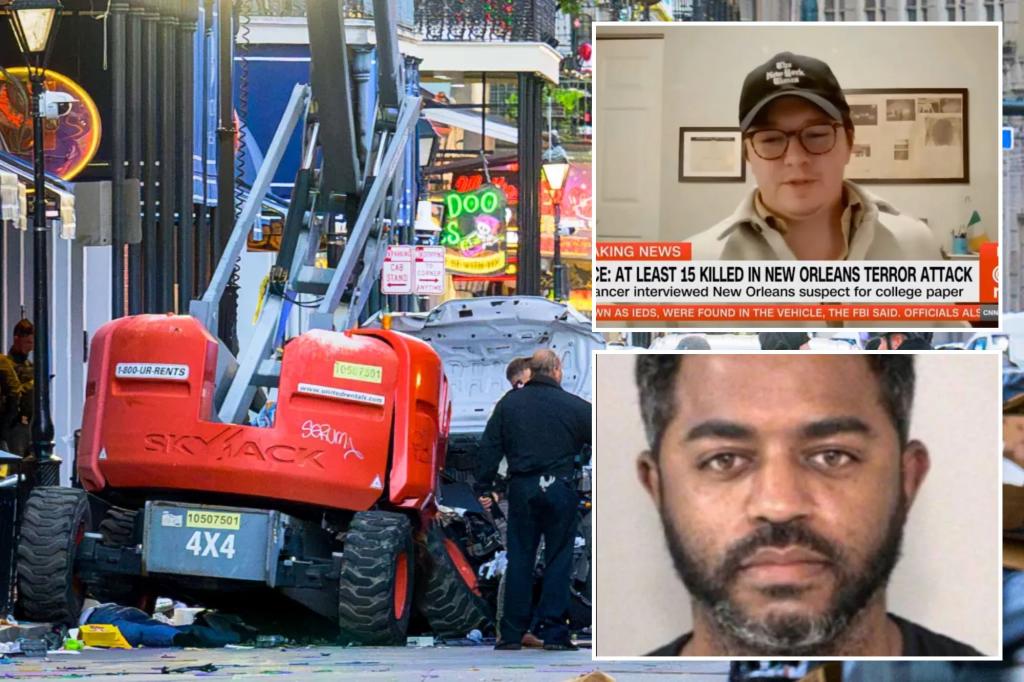The early hours of New Year’s Day in 2024 were shattered by a horrific act of violence in New Orleans. Shamsud-Din Jabbar, a 42-year-old US Army veteran, drove a rented Ford pickup truck, emblazoned with an ISIS flag, into a crowd of revelers, leaving a trail of carnage and devastation. The attack, which claimed the lives of at least 15 people and injured dozens more, immediately prompted an FBI investigation into its potential connection to terrorism. Jabbar, who resided in a dilapidated trailer park on the outskirts of the city, was ultimately killed in a shootout with police officers, ending his reign of terror. The incident sent shockwaves through the nation, prompting questions about Jabbar’s motives and background.
In the aftermath of the tragedy, a decade-old interview resurfaced, shedding some light on Jabbar’s past. Sean Keenan, a journalist for the New York Times, had interviewed Jabbar in 2015 while they were both students at Georgia State University. Keenan’s recollection of Jabbar painted him as a “cool, calm, and collected” individual, exhibiting no overt warning signs. However, Keenan also noted a certain reserved demeanor and distance about Jabbar, reminiscent of veterans grappling with the aftermath of challenging deployments. This observation hinted at the potential internal struggles Jabbar faced as he transitioned from military life back into civilian society. The interview focused on the difficulties veterans encountered navigating the bureaucratic maze of the GI Bill and the challenges of readjusting to civilian communication, devoid of military jargon.
Jabbar’s academic pursuits at Georgia State University, where he earned a bachelor’s degree in computer information systems between 2015 and 2017, offered a glimpse into his post-military aspirations. His eight-year tenure in the Army, including a deployment to Afghanistan and subsequent service in the Army Reserve until 2020, shaped his experiences and worldview. The 2015 interview provided a platform for Jabbar to articulate the frustrations veterans faced in accessing their education benefits and the linguistic disconnect they experienced upon returning to civilian life. He highlighted the ingrained use of military terminology and the difficulty in adapting to civilian communication norms.
Further insights into Jabbar’s past emerged from Chris Pousson, a retired Air Force veteran and childhood friend. Pousson recalled Jabbar as a well-dressed, academically successful student who steered clear of trouble during their formative years. However, upon reconnecting with Jabbar via Facebook after his military service, Pousson observed a stark transformation. While never explicitly threatening violence, Jabbar displayed a newfound fervor for his faith, a passion that seemed to consume him. This shift in behavior raises questions about the potential influence of extremist ideologies on Jabbar’s trajectory.
The discovery of several pipe bombs within the truck and scattered throughout the French Quarter significantly broadened the scope of the investigation. Surveillance footage initially suggested the involvement of other individuals alongside Jabbar in planting the devices, leading the FBI to suspect a broader conspiracy. FBI Special Agent Alethea Duncan publicly stated the belief that Jabbar was not acting alone, fueling speculation of a coordinated attack. However, subsequent investigations cleared the individuals captured in the surveillance footage, seemingly refocusing the investigation on Jabbar as the sole perpetrator.
The complexities surrounding the New Orleans attack underscore the challenges in identifying and mitigating acts of domestic terrorism. Jabbar’s seemingly unremarkable past, coupled with the absence of clear warning signs, raises questions about the efficacy of current threat assessment protocols. The incident highlights the need for deeper understanding of the factors contributing to radicalization and the development of more robust strategies for identifying individuals at risk of engaging in extremist violence. The tragedy serves as a stark reminder of the ongoing threat of domestic terrorism and the imperative to enhance preventative measures while respecting individual liberties.
The investigation into the New Orleans attack remains ongoing, with authorities striving to piece together the full narrative of events leading up to the tragedy. While the initial suspicion of a wider conspiracy involving multiple actors appears to have diminished, the focus now centers on understanding Jabbar’s motivations and the path that led him to perpetrate this horrific act. Unraveling the complex web of factors contributing to his radicalization is crucial for developing effective counterterrorism strategies and preventing future tragedies. The nation mourns the victims of this senseless violence while grappling with the enduring questions surrounding the roots of extremism and the challenge of safeguarding communities from those who embrace it.

